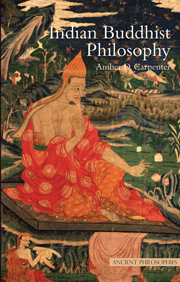Book contents
- Frontmatter
- Contents
- Preface
- Acknowledgements
- Abbreviations
- Chronology
- Development of Buddhist thought in India
- 1 The Buddha's suffering
- 2 Practice and theory of no-self
- 3 Kleśas and compassion
- 4 The second Buddha's greater vehicle
- 5 Karmic questions
- 6 Irresponsible selves, responsible non-selves
- 7 The third turning: Yogācāra
- 8 The long sixth to seventh century: epistemology as ethics
- Epilogue
- Background information
- Notes
- Bibliography
- Index
4 - The second Buddha's greater vehicle
- Frontmatter
- Contents
- Preface
- Acknowledgements
- Abbreviations
- Chronology
- Development of Buddhist thought in India
- 1 The Buddha's suffering
- 2 Practice and theory of no-self
- 3 Kleśas and compassion
- 4 The second Buddha's greater vehicle
- 5 Karmic questions
- 6 Irresponsible selves, responsible non-selves
- 7 The third turning: Yogācāra
- 8 The long sixth to seventh century: epistemology as ethics
- Epilogue
- Background information
- Notes
- Bibliography
- Index
Summary
The Bodhisattva Avalokitešvara, while moving in the deep course of Perfect Understanding [prajña paramitā], shed light on the five skandhas and found them all equally empty. After this penetration, he overcame all pain.
(“The Heart Sutra”)With Nāgārjuna, we encounter the first named Buddhist philosopher. His impact on the character of Buddhist thought was so massive that he is sometimes hailed as the ‘second Buddha’. But he is an elusive figure. Very little is known of him personally, except that he is probably from an educated Brahmin family in the south of India, and was working in the first to second centuries CE. Trained in the Vedic tradition, Nāgārjuna established the practice of discussing Buddhism in Sanskrit, the shared language of the educated classes, rather than in Pāli or some other vernacular, thus bringing Buddhist and non-Buddhist thought into a common linguistic and intellectual space.
Nāgārjuna is elusive in another way. Such was his eventual popularity and esteem that, like Pythagoras in the Graeco-Roman world, Nāgārjuna had many views and texts retrospectively fathered on him, so that it is particularly difficult to discern the man from the myth. If we take ‘Nāgārjuna’ to refer to ‘the founder of Madhyamaka’, then we can use one prominent text, the Mūla-madhyamaka-kārikā as criterial.
- Type
- Chapter
- Information
- Indian Buddhist Philosophy , pp. 72 - 92Publisher: Acumen PublishingPrint publication year: 2013

